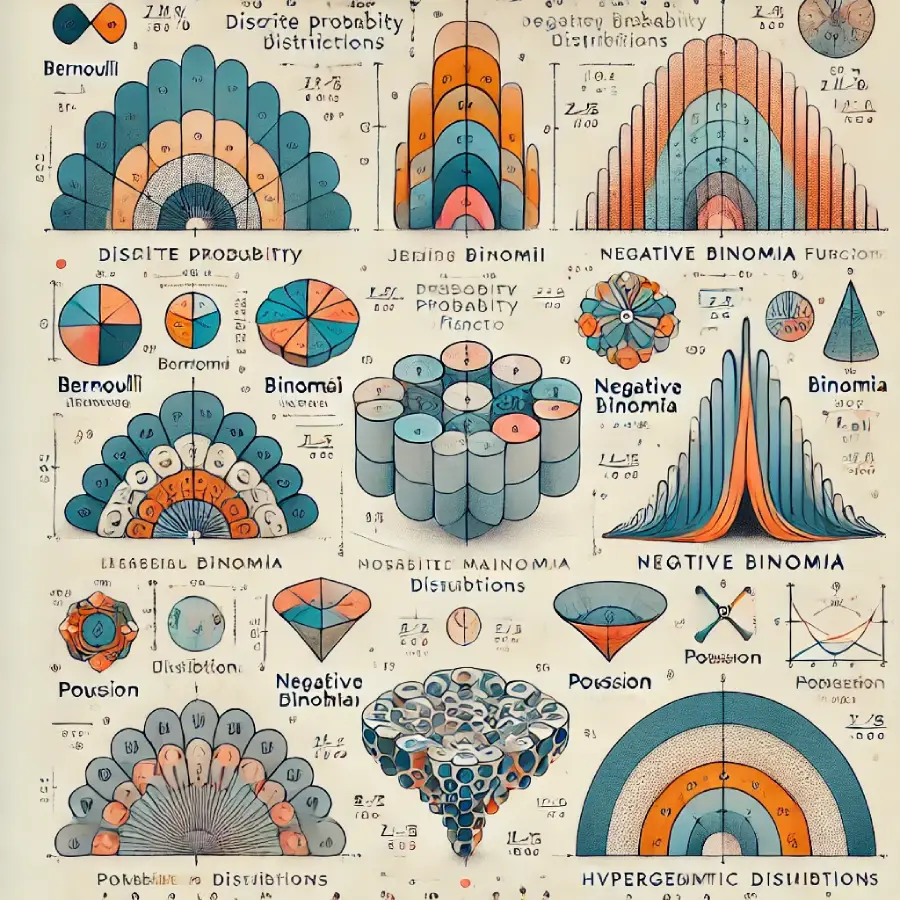In probability theory, several discrete probability distributions are widely used. These distributions describe the probabilities of outcomes in different types of experiments or scenarios where the outcomes are distinct and countable. Here are the main discrete distributions:
1. Bernoulli Distribution
– Description: Describes a single experiment (or trial) with two possible outcomes: success (with probability \(p\)) or failure (with probability \(1-p\)).
– Support: \(x \in \{0, 1\}\)
– Probability Mass Function (PMF):
\[
P(X = x) = \begin{cases}
p & \text{if } x = 1, \\
1 – p & \text{if } x = 0.
\end{cases}
\]
– Mean: \(p\)
– Variance: \(p(1-p)\)
2. Binomial Distribution
– Description: Describes the number of successes in a fixed number of independent Bernoulli trials.
– Support: \(x \in \{0, 1, 2, \dots, n\}\)
– Parameters: \(n\) (number of trials), \(p\) (probability of success)
– PMF:
\[
P(X = x) = \binom{n}{x} p^x (1-p)^{n-x}
\]
– Mean: \(np\)
– Variance: \(np(1-p)\)
3. Geometric Distribution
– Description: Describes the number of trials needed to get the first success in a series of independent Bernoulli trials.
– Support: \(x \in \{1, 2, 3, \dots\}\)
– Parameter: \(p\) (probability of success)
– PMF:
\[
P(X = x) = (1-p)^{x-1} p
\]
– Mean: \(\frac{1}{p}\)
– Variance: \(\frac{1-p}{p^2}\)
4. Negative Binomial Distribution
– Description: Generalizes the geometric distribution to describe the number of trials needed to achieve \(r\) successes.
– Support: \(x \in \{r, r+1, r+2, \dots\}\)
– Parameters: \(r\) (number of successes), \(p\) (probability of success)
– PMF:
\[
P(X = x) = \binom{x-1}{r-1} p^r (1-p)^{x-r}
\]
– Mean: \(\frac{r}{p}\)
– Variance: \(\frac{r(1-p)}{p^2}\)
5. Poisson Distribution
– Description: Describes the number of events occurring within a fixed interval of time or space, given that these events happen with a known constant mean rate and independently of the time since the last event.
– Support: \(x \in \{0, 1, 2, \dots\}\)
– Parameter: \(\lambda\) (average rate of occurrence)
– PMF:
\[
P(X = x) = \frac{\lambda^x e^{-\lambda}}{x!}
\]
– Mean: \(\lambda\)
– Variance: \(\lambda\)
6. Hypergeometric Distribution
– Description: Describes the number of successes in a sequence of \(n\) draws from a finite population of size \(N\) that contains exactly \(K\) successes, without replacement.
– Support: \(x \in \{ \max(0, n – (N-K)), \dots, \min(n, K) \}\)
– Parameters: \(N\) (population size), \(K\) (number of successes in the population), \(n\) (number of draws)
– PMF:
\[
P(X = x) = \frac{\binom{K}{x} \binom{N-K}{n-x}}{\binom{N}{n}}
\]
– Mean: \(\frac{nK}{N}\)
– Variance: \(\frac{nK(N-K)(N-n)}{N^2(N-1)}\)
These distributions are foundational in probability theory and are applied in various fields such as statistics, finance, engineering, and the natural sciences.

